

In The Netherlands, Belgium, Germany and Spain Astronet, Kennislink, Astroforum, Sterrenkids, Dutch Copernicus Public Observatory, Belgian Mira Public Observatory, Spanish Serviastro, Associación Argentina "Amigos de la Astronomía" in Argentina and Hochschule Offenburg in Germany organized live webcasts of the event. Most webcast were clouded out or had a partrial view of the eclipse. Only in argentina Luis Manzerola and his team of the Asociación Argentina "Amigos de la Astronomía" viewed a complete eclipse:
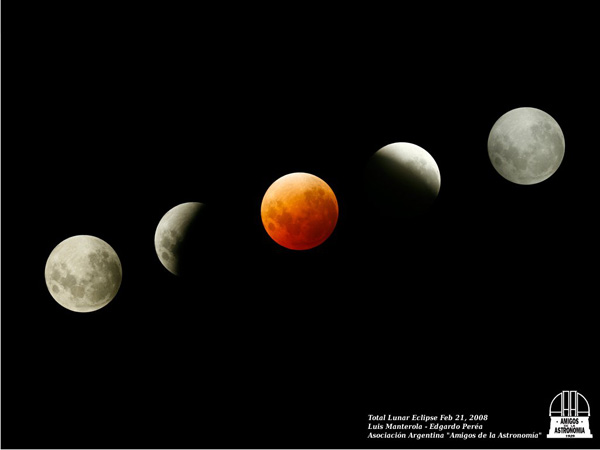
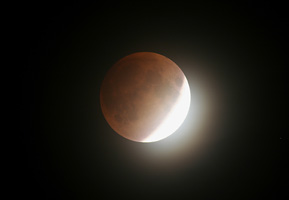 |
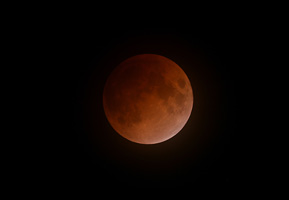 |
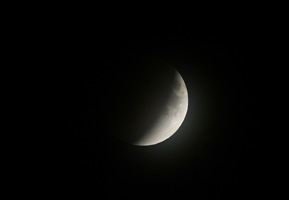 |
In the Netherlands Bas and Brechje van Beek of Skyglory captured the eclipse through a 101mm F5.4 Genesis Tele Vue telescope using a Canon 350DH camera, sensitized for H-alpha, at 200 ASA.
Norbert Schmidt (pictured below left behind the computer) webcasted the eclipse from Copernicus Public Observatory. He took this shot of totality at 03:04 UT.
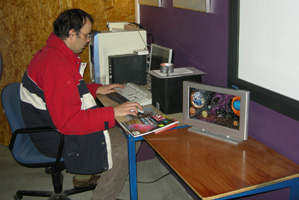 |
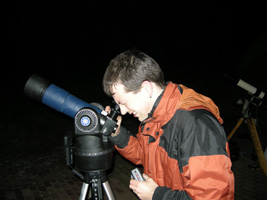 |
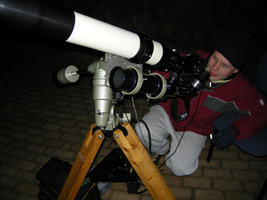 |
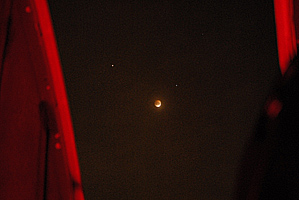 |
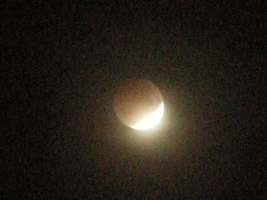 |
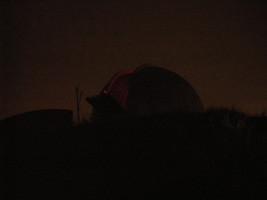 |
In the Netherlands many observers gathered at Copernicus Public Observatory. At times they experienced fog, but in general the eclipse could be followed untill mid-totality.
Carl Koppeschaar observing at Copernicus Public Observatory.
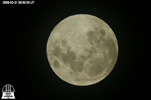 |
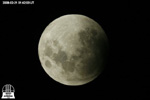 |
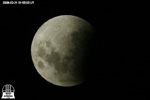 |
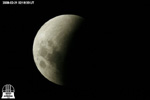 |
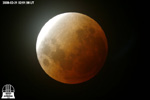 |
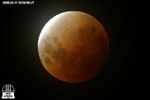 |
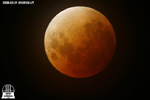 |
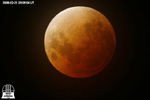 |
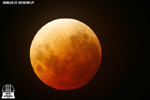 |
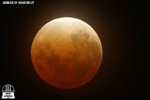 |
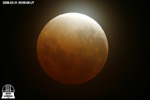 |
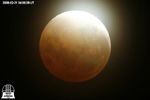 |
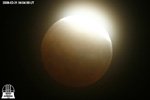 |
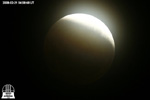 |
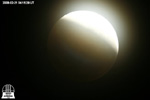 |
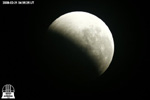 |
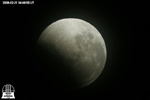 |
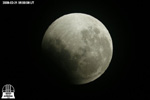 |
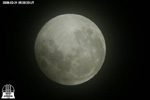 |
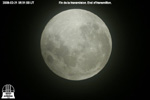 |
Copyright: Asociación Argentina "Amigos de la Astronomía"
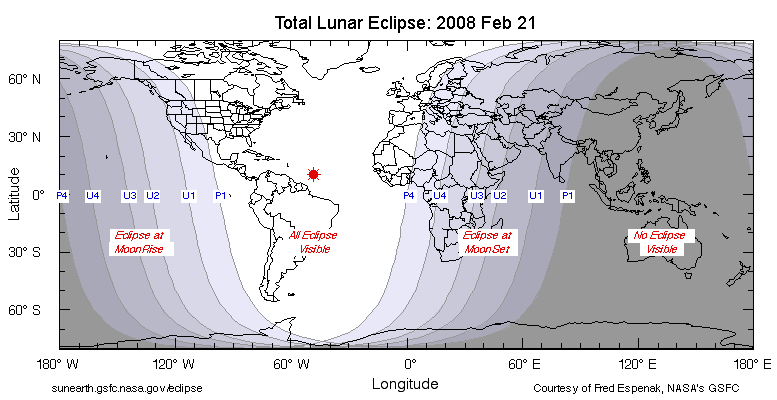
A lunar eclipse occurs when the Full Moon passes through the Earth's shadow.
The Moon encounters the penumbra, the Earth's outermost shadow zone, at 00:35 Universal Time (UT). About thirty minutes later a slight dusky shading can be noticed on the leading edge of the Moon.
At 01:43 UT the Moon begins its entry into the innermost shadow zone, or umbra. For more than an hour a circular shadow creeps across the Moon's face. At 03:01 UT, the Moon is completely within Earth's dark shadow. It then takes on an eerie coppery tint that can be compared with the colour of blood.
 During a total eclipse the Moon shines with a orange reddish glow. Photograph: Robert Smallegange (Leeuwarden, The Netherlands). |
Without Earth's atmosphere, the Moon would disappear completely once immersed in the umbra. Longer wavelengths of light penetrate Earth's atmosphere better than shorter wavelengths, which is why the rising or setting sun looks reddish. In essence, the ruddy tint of a totally eclipsed moon comes from the ring of atmosphere around Earth's limb that scatters a sunset-like glow into the umbra.
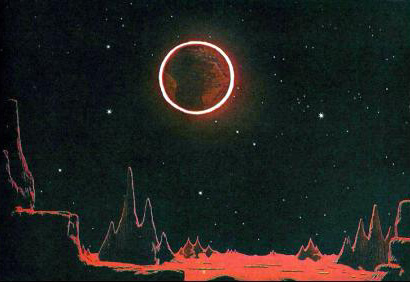 During totality a ring of reddish sunlight surrounds the Earth. |
The hue actually changes from one eclipse to another, ranging from a bright coppery orange to brownish. The Moon may darken so much that it becomes all but invisible to the unaided eye. These very dark lunar eclipses often occur after exceptional volcanic eruptions.
Totality ends at 03:51 UT, when the moon's leading edge exits the umbra. The moon leaves the umbra completely at 05:09 UT, and the eclipse ends at 06:17 UT when the moon makes its last contact with the penumbra.
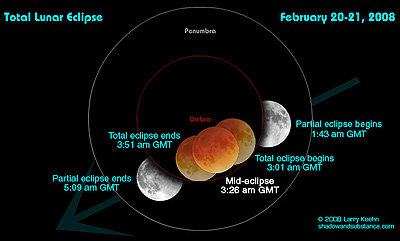 Path of the Moon through Earth's umbral and penumbral shadows during the Total Lunar Eclipse of February 20-21, 2008. Times in UT (= GMT). Courtesy: Science@NASA/Larry Koehn. More animations at Shadow & Substance. |
Request of observations
Dr. Richard Keen (Program for Atmospheric and
Oceanic Sciences (PAOS), University of Colorado) is interested in
brightness estimates (total visual magnitude and Danjon L values) of the moon during
totality. His plan is to summarize the results from the 2003-2004 series of lunar
eclipses in the Smithsonian Volcano Bulletin after this eclipse of October.
Richard Keen communicates:
Dear observer,
This is a mass mailing to all of you who have observed lunar eclipses in the past and/or have an interest in these events. Last week I gave a presentation at a climate conference which included some results of your observations, and a copy of the presentation is attached to this message.
Once again, I would be interested in hearing of your observations of this week's eclipse (Wednesday evening, February 20. on the west side of the Atlantic and Thursday morning for those on the east side of the Atlantic). Some of you may make "reverse binocular" magnitude estimates, or Danjon "L" estimates, or both. Below are some web links with information about the eclipse and about observing methods, along with links to presentations at the climate conference your observations were presented at. In summary, the recent eclipses show that the atmosphere has been clear of volcani aerosols since about 1995, and that this has contributed about 0.2 degrees to the recent warming.
Enjoy clear skies for the eclipse!
Dr. Richard Keen
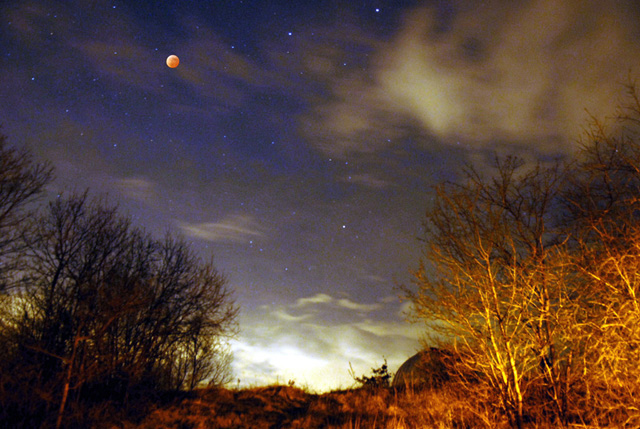
Here's a brief description of one way to measure the brightness of a lunar eclipse:
The totally eclipsed moon is usually brighter than most comparison stars (expect about magnitude -3 at second and third contacts, and -1.4 at mid-totality, assuming no volcanic dust present), and its brightness needs to be reduced before a direct comparison can be made. An easy way to do this is to view the moon through reversed binoculars with one eye, comparing the reduced lunar image with stars seen directly with the other eye. The estimated magnitude of the reduced moon can be adjusted by a factor depending on the magnification of the binoculars, yielding the actual magnitude of the moon. For example, reversed 10x50 binoculars will reduce the apparent diameter of the moon by a factor of 10, or its brightness by a factor of 100, or 5 magnitudes. If the reduced moon appears like a magnitude 3 star, the actual moon is 5 magnitudes brighter, or -2. The corrections for 8x, 7x, and 6x binoculars are 4.5, 4.2, and 3.9 magnitudes, respectively. These correction factors assume the stated magnification of the binoculars is correct, and neglects light loss in the optics. More accurate correction factors can be empirically derived from observations of Venus, Jupiter, or Sirius.
Observations made from the beginning to end of totality will reveal the darkening of the moon as it slips deeper into the umbra, but the most useful observations (for measuring volcanic dust) are those taken near mid-totality.
Reports should include time(s) of observation, size of binoculars (or other method) used, and identity of comparison stars or planets.
Articles about how volcanoes can affect the brightness of a lunar eclipse:
Here are predictions for the immersions and emersions of craters and mountains on the Moon:
Immersion and Emersion Times (UT) for the Total Lunar Eclipse of February 21, 2008
Immersion Crater/mountain Emersion
01.46 Riccioli 04.06
01.48 Grimaldi 04.05
01.49 Aristarchus 04.22
01.53 Kepler 04.19
01.55 Billy 04.06
01.56 Harpalus 04.35
01.57 Bianchini 04.36
02.00 Pytheas 04.30
02.01 Copernicus 04.27
02.03 Timocharis 04.36
02.05 Pico 04.43
02.05 Plato 04.44
02.08 Piton 04.44
02.10 Autolyticus 04.43
02.11 Campanus 04.08
02.14 Aristoteles 04.52
02.15 Eudoxus 04.51
02.16 Manilius 04.42
02.19 Menelaus 04.46
02.23 Dionysius 04.42
02.24 Plinius 04.49
02.24 Endymion 05.02
02.27 Vitruvius 04.53
02.27 Tycho 04.07
02.33 Censorinus 04.47
02.34 Proclus 04.59
02.37 Taruntius 04.55
02.40 Messier 04.52
02.42 Goclenius 04.47
02.47 Langrenus 04.53
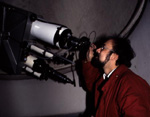 Carl Koppeschaar |
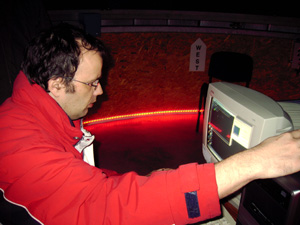 Norbert Schmidt |
 Arnold Tukkers |
 Philippe Mollet |
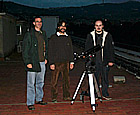 Eduard Masana (left), Victor Gómez, Salvador Ribas (right) |
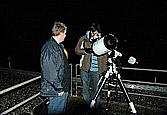 Hochschule Offenburg |
 Luis Manterola |
 |
 |
 |
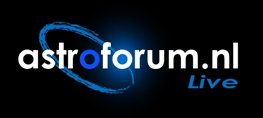 |
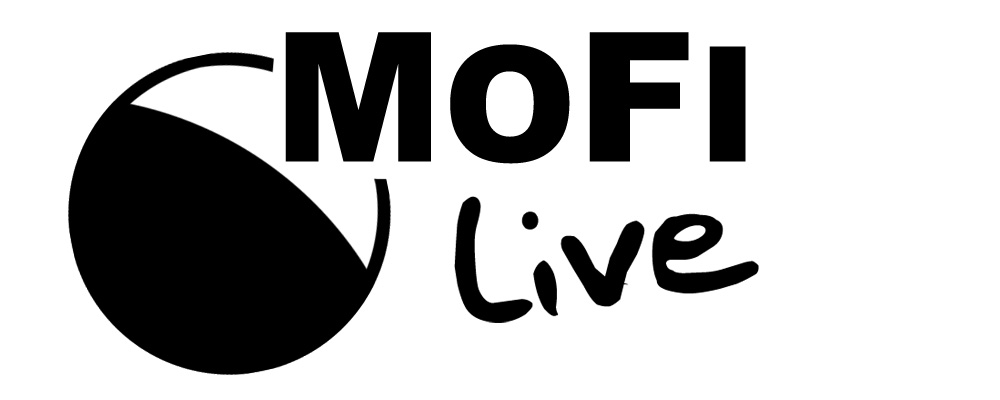 |
 |
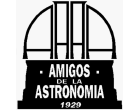 |
 |
 |